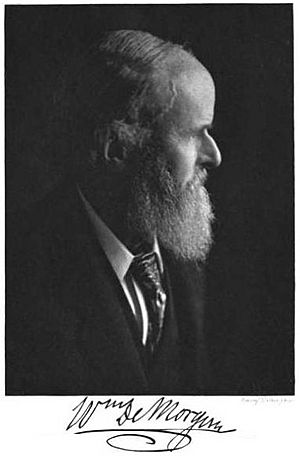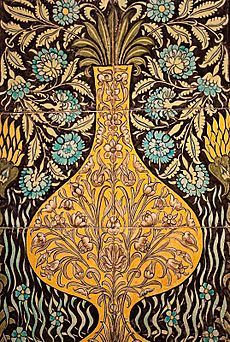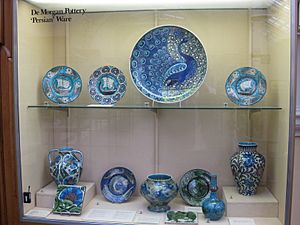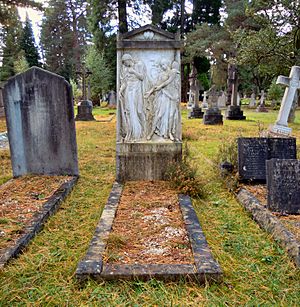William De Morgan facts for kids
William Frend De Morgan (born November 16, 1839 – died January 15, 1917) was a talented English artist. He was famous for his beautiful pottery and tile designs. He also became a well-known writer later in life.
William was a lifelong friend of William Morris, another famous artist. De Morgan designed tiles, stained glass, and furniture for Morris's company, Morris & Co., from 1863 to 1872. His tiles often looked like old medieval or Islamic art. He was very good at creating new types of glazes and ways to fire his pottery. You can often see ships, fish, and amazing birds or animals in his designs. Many of his tiles were made to fit together to create large, detailed patterns.
Contents
Life and His Art Journey
William De Morgan was born in London. His father, Augustus De Morgan, was a famous mathematician, and his mother, Sophia Elizabeth Frend, was also very smart. They supported William's dream to become an artist.
When he was 20, William started studying at the Royal Academy schools. But he quickly felt that the traditional art school wasn't for him. Then he met William Morris and joined the Pre-Raphaelite art group. This group liked art that was inspired by earlier, simpler styles.
Becoming a Potter
William began trying out stained glass art. In 1863, he started working with pottery. By 1872, he was completely focused on ceramics. He first worked in Fitzroy Square in London.
In 1872, De Morgan opened his own pottery workshop in Chelsea. He stayed there until 1881. This was a very busy and creative time for him. Because of his friendship with Morris, William was interested in the "Arts and Crafts" movement. This idea encouraged artists to explore every part of their craft.
William loved to experiment. He spent hours trying to create new glazes and better ways to fire his pottery. He even designed a special bicycle gear! At first, some of his early tiles had small flaws, but he kept working to make them better. He often bought blank tiles from other companies like Wedgwood and Mintons and then decorated them himself. Later, he developed his own special tile that he liked because it had unique textures and was good at resisting moisture.
His Pottery Designs
De Morgan decorated many different pottery items, like large plates, rice dishes, and vases. Some of these were made in his own workshop. Others were bought as plain pottery from companies like Wedgwood and then decorated by his team. Some pieces were even signed by his decorators, such as Charles Passenger and Fred Passenger.
William was especially interested in tiles from Eastern countries. Around 1873–1874, he made an exciting discovery. He figured out how to create "lustreware" again. This pottery has a shiny, metallic surface, like old Spanish and Italian pottery.
His interest in Eastern art wasn't just about glazes. It also changed his ideas about design and color. By 1875, he started using a "Persian" color palette. This included dark blue, turquoise, purple, green, red, and lemon yellow. He studied designs from what he called "Persian" pottery (which we now know as İznik ware from the 15th and 16th centuries). These designs greatly influenced his unique style. He often created fantastic creatures mixed with flowing geometric shapes, all under his bright, shiny glazes.
Later Life and Writing
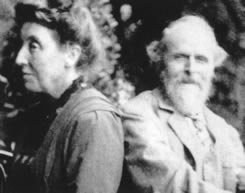
William's pottery business often struggled with money. His wife, the Pre-Raphaelite painter Evelyn De Morgan, helped him with money many times. He also partnered with an architect named Halsey Ricardo. In 1888, the factory moved from Merton Abbey to Fulham. During this time in Fulham, William became very skilled at the technical parts of his work. He mastered complex shiny glazes and deep, bright colors that didn't run when fired.
However, even with his amazing skills, the business didn't become a big financial success. In 1907, William left the pottery business. It was continued by the Passenger brothers, who were his main painters. William once said, "All my life I have been trying to make beautiful things, and now that I can make them nobody wants them."
After leaving pottery, William started writing novels. He became more famous as a writer than he ever was for his pottery! His first novel, Joseph Vance, was published in 1906. It was an instant hit in both the United States and the United Kingdom. He then wrote other books like An Affair of Dishonour and Alice-for-Short. His stories are often described as being about everyday life in Victorian times.
William De Morgan passed away in London in 1917. He was buried in Brookwood Cemetery. People who knew him remembered him as a warm person with amazing energy. He had a varied career as a designer, potter, inventor, and novelist.
Where to See His Work
You can find collections of William De Morgan's work in many museums. Some of these include the Victoria and Albert Museum and the William Morris Gallery in London. The Birmingham Museum and Art Gallery has a large collection, and there's a smaller one at Norwich.
From 2002 to 2014, there was a special exhibition of his work and his wife Evelyn's art at the De Morgan Centre in London. His famous Dragon Charger is in the Dunedin Public Art Gallery in New Zealand. The National Gallery of Canada in Ottawa also has a good collection of his work. You can also see his art in other major collections like the Art Gallery of Ontario in Canada, the Musée d'Orsay in Paris, and the Fitzwilliam Museum, Cambridge.
Many places in the UK that are open to the public have his tiles and pottery on display. These include Wightwick Manor, Standen, and Leighton House. After his death, William's sister-in-law collected his ceramics, papers, and artworks. These are now part of the De Morgan Foundation collection. You can see some of these artworks at Cannon Hall in Barnsley and at Watts Gallery in Surrey. A selection of his ceramics is also on long-term loan to the Ashmolean Museum in Oxford.
See also
- De Morgan Foundation
- Arts and Crafts movement


